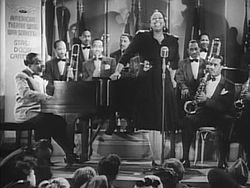Count Basie & His Orchestra
| The Count Basie Orchestra | |
|---|---|

The Count Basie Orchestra with vocalist Ethel Waters from the film Stage Door Canteen (1943)
|
|
| Background information | |
| Origin | Kansas City, Missouri |
| Genres | Jazz, big band, swing |
| Years active | 1935–present |
| Website | thecountbasieorchestra |
The Count Basie Orchestra is a 16 to 18 piece big band, one of the most prominent jazz performing groups of the swing era, founded by Count Basie in 1935 and recording regularly from 1936. Despite a brief disbandment at the beginning of the 1950s, the band survived long past the Big Band era itself and the death of Basie in 1984. It continues as a 'ghost band'.
Originally including such musicians as Buck Clayton and Lester Young in the line-up, the band in the 1950s and 1960s made use of the work of such arrangers as Neal Hefti and featured musicians such as Thad Jones and Eddie "Lockjaw" Davis. Its recordings of this era included collaborations with singers such as Frank Sinatra and Ella Fitzgerald.
Count Basie arrived in Kansas City, Missouri in 1927, playing on the Theater Owners Bookers Association (TOBA) circuit. After playing with Walter Page's Blue Devils, in 1929 he joined rival band leader Bennie Moten's band.
Upon Moten's death in 1935, Basie left the group to start his own band, taking many of his colleagues from the Moten band with him. This nine-piece group consisted of Joe Keyes and Oran 'Hot Lips' Page on trumpet, Buster Smith and Jack Washington on alto saxophone, Lester Young on tenor saxophone, Dan Minor on trombone, and a rhythm section made up of Jo Jones on drums, Walter Page on bass and Basie on piano. With this band, then named The Barons of Rhythm, Basie brought the sound of the famous and highly competitive Kansas City "jam session" to club audiences, coupling extended improvised solos with riff-based accompaniments from the band. The group's first venue was the Reno Club in Kansas City, later moving to the Grand Terrace in Chicago.
...
Wikipedia
